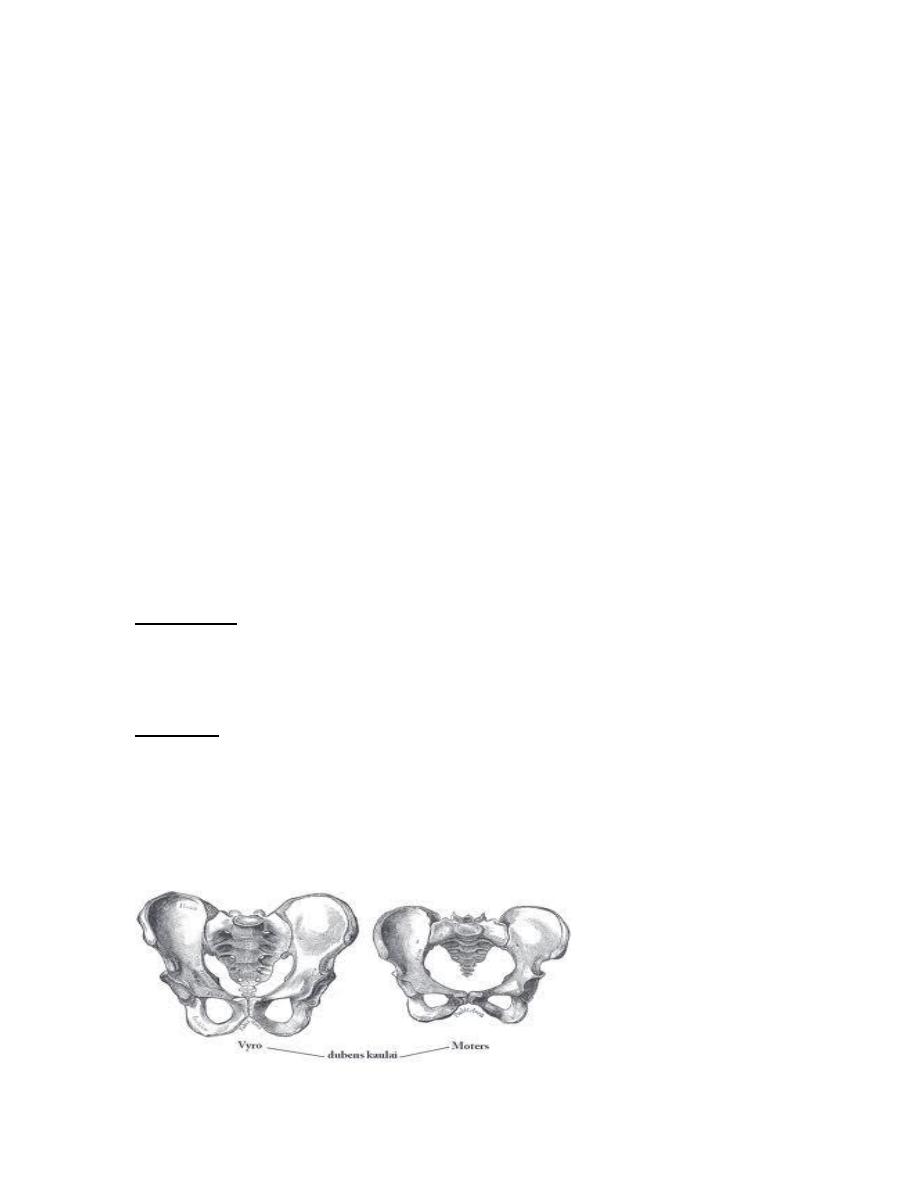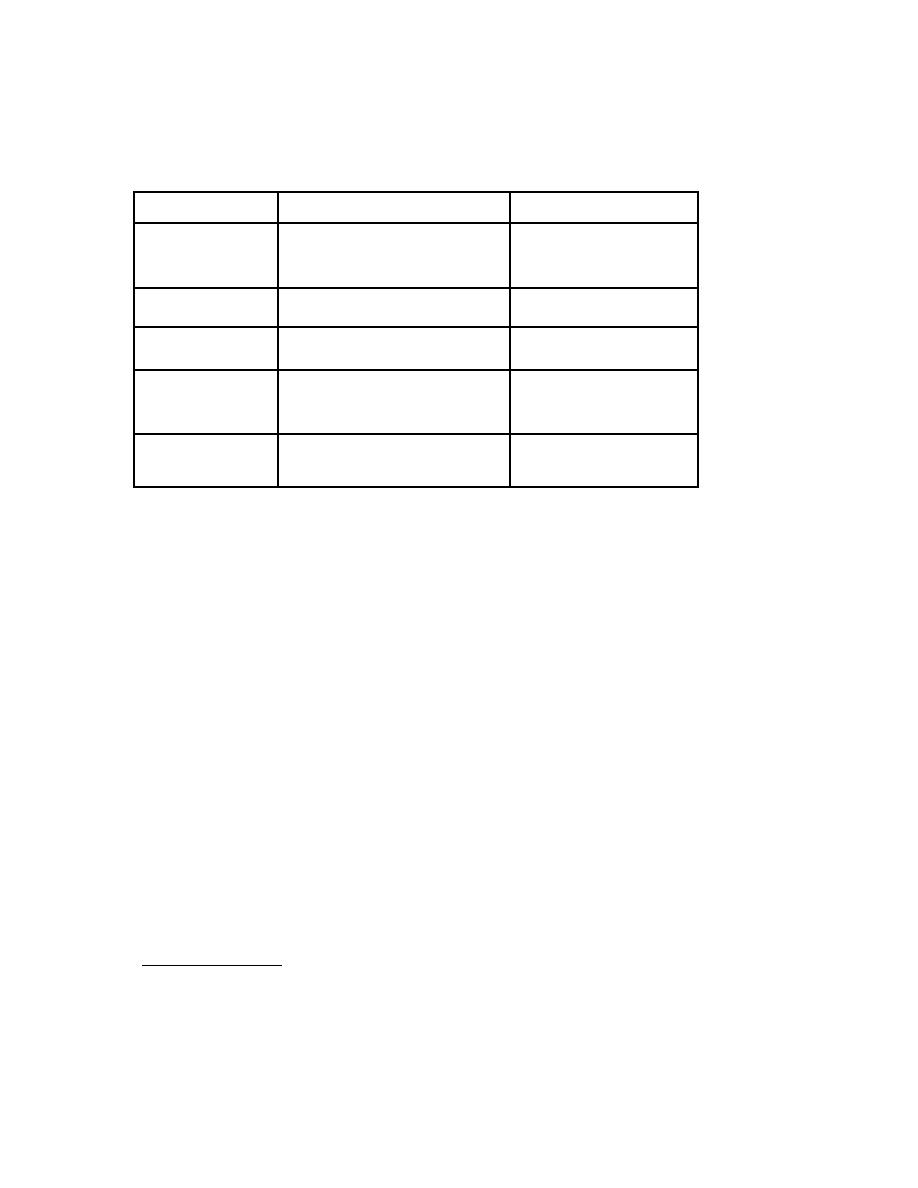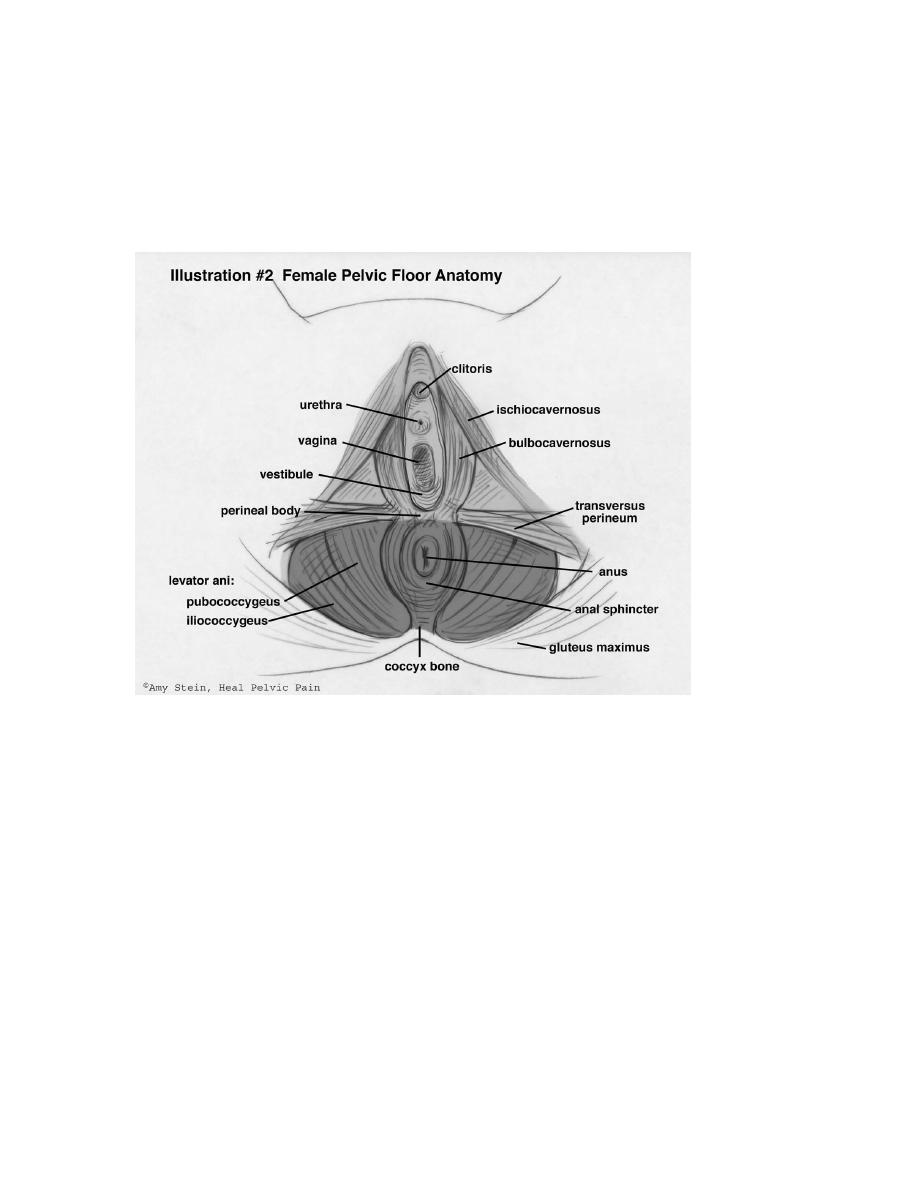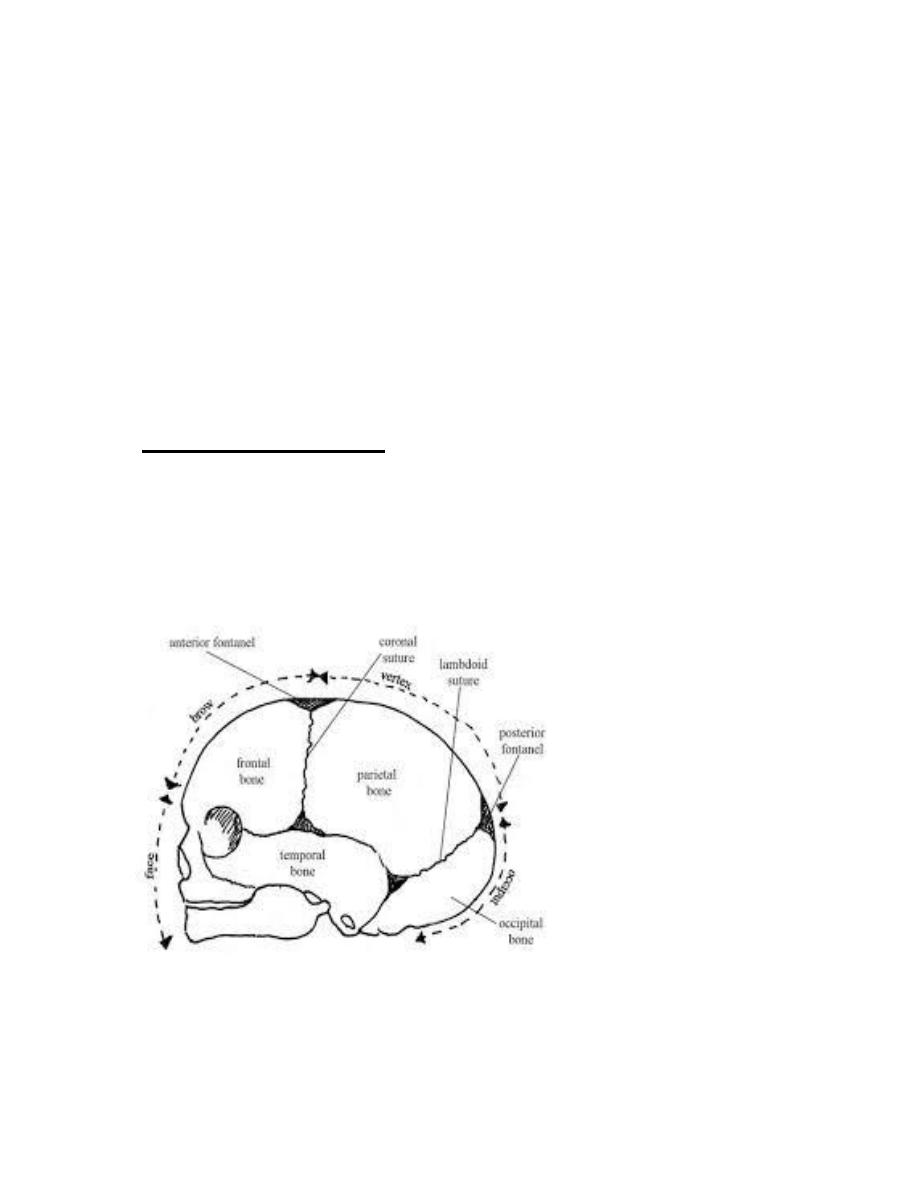
Female pelvis and fetal skull
Female pelvis:
Pelvic Girdle (Hip)
The female pelvis is formed by a pair of hip bones (innominate) bones, the sacrum and
the coccyx.
The pelvis attaches the lower limbs to the axial skeleton with the strongest ligaments of
the body and transmits weight of the upper body to the lower limbs, also it supports the
visceral organs of the pelvis.
* Each hip bone compose of pubic bone in front with its upper and lower rami, the
ischium below, and the ilium above. They meet together at a cup shape fossa that
articulate with the head of the femur called the acetabulum.
* The two hip bones join with each at the pubic symphysis anteriorly and with sacrum
via the sacral alae at the sacroiliac joint.
Each hip bones consist of:
1- Ilium: It consists of a body and a superior wing like portion called the ala,
the broad postero-lateral surface is called the gluteal surface, the auricular surface
articulates with the sacrum (sacroiliac joint) and the major markings include the iliac
crests, four spines, greater sciatic notch, iliac fossa, arcuate line, and the pelvic brim.
2- Ischium: The ischium forms the posteroinferior part of the hip bone and consist of a
body and a ramus. The thick body form 2/5 of the acetabulum articulates with the ilium,
and the thinner ramus articulates with the pubis. Major markings include the *ischial
spine (the sacrospinal ligament binds to it), lesser sciatic notch, and the *ischial
tuberosity (the sacrotuberous ligament bind to it) are two important landmarks in
obstetrics.
3- Pubis: The pubic bone forms the anterior portion of the hip bone. It articulates with
the ischium and the ilium. Has a body, superior and inferior rami that unite with ishial
ramus to bound the obturator foramen. The superior ramus fuses with the ilium at the
iliopubic eminence and form about 1/5 of the acetabulum. Major markings include
superior and inferior rami, the pubic crest, pubic tubercle, pubic arch, pubic symphysis,
and obturator foramen (along with ilium and ischium)
Sacrum: Compose of 5 fused vertebrae. It is triangular in shape with anterior projection
called sacral promontory and paired rows of foramina on the dorsal and pelvic surfaces.
The sacral hiatus is used to introduce anesthetic solutions to sacral canal to block the
sacral nerves (it represents the lower sacral canal that is deficient posteriorly but covered
with fibrous tissue only).

Coccyx:
Is small triangular structure, formed by fusion of four coccygeal vertebrae and articulate
with the sacrum, it gives attachment to the sacrotuberous ligament and levator ani
muscle.
Joints:
1- Sacroiliac joint; it is synovial joint between the sacrum and the ilium, supported by
ventral and dorsal sacroiliac ligaments.
2- Sacrococcugeal joints; secondary cartilaginous joint, has considerable mobility which
increased late in pregnancy that the joint may be dislocated.
3- Symphysis pubis; secondary cartilagenous joint between the two pubic bones. The
joint is supported by inferior and superior ligaments.
Ligaments:
1- Sacrotuberous ligament; between posterior iliac spines and the postero-lateral aspect of
the sacrum and coccyx to the ischial tuberosity.
2- Sacrospinal ligament; from lateral border of sacrum and coccyx to the ishial spine.
* The two ligaments with the ischium form the boundaries of the greater and lesser
sciatic foramina.
* Pelvic ligaments loosen during pregnancy and become stretched so help to increase
pelvic diameters during labour.
Comparison of Male and Female Pelvic Structure:
Female pelvis
Tilted forward, adapted for childbearing
True pelvis defines birth canal
Cavity of the true pelvis is broad, shallow, and has greater capacity
Male pelvis
Tilted less forward
Adapted for support of heavier male build and stronger muscles
Cavity of true pelvis is narrow and deep
Male Female

Comparison of Male and Female Pelvic Structure
Characteristic
Female
Male
Bone thickness
Lighter, thinner, and
smoother
Heavier, thicker, and
more prominent
markings
Pubic arch/angle
80˚–90˚
50˚–60˚
Acetabula
Small; farther apart
Large; closer together
Sacrum
Wider, shorter; sacral
curvature is accentuated
Narrow, longer; sacral
promontory more
ventral
Coccyx
More movable; straighter
Less movable; curves
ventrally
Anatomic Landmarks
Components of pelvimetry
Forepelvis
Sidewalls
Ischial spines
Sacrosciatic ligament/notch
Coccyx
Sacrum
Diagonal conjugate
Pubic arch
Bituberous diameter
The Bony Pelvis
Functions to support and protect the pelvic contents and to form the relatively fixed axis
of the birth passage.
Made up of hip bones, the sacrum and the coccyx. Ischial spines serve as a reference
point during labor to evaluate descent of the fetal head into the birth canal.
The true pelvis is divided into three sections: inlet, midpelvis and outlet. Represents the
bony limits of the birth canal.
Pelvic inlet (brim):
*The pelvis is divided by an imaginary line through the pelvic brim into false pelvis
(above) and true pelvis (below).
*It is represented by the line that runs from the upper border of symphysis pubis
anteriorly and the upper margin of the superior pubic ramus, the iliopectineal line on each
side and the ala of the sacrum and sacral promontory posteriorly.

* The inlet forms a plane that makes 60 degree with the horizontal in erect position
called (pelvic inclination). But in Afro- Caribbean women this angle may as much as 90
degree, this increased angle may delay the head entering the pelvis in labour.
* In a gynecoid pelvis: the transverse diameter of the inlet is about 13.5 (largest
diameter), which is the widest distance between selected points on the two iliopectineal
lines.
The anterior- posterior diameter is about 11cm, it is the distance between the upper
border of the symphysis pubis to the tip of the sacral promontory.
Mid cavity:
*It it’s the area that bounded by the middle of the symphsis pubis in front, pubic bones on
each side, obturator fascia and the inner aspect of the ischial bone and posteriorly by the
junction of the 2
nd
and 3
rd
piece of the sacrum.
*It is rounded with equal transverse, A-P, and oblique diameters, they are about 12 cm.
* The ischial spine are palpable vaginally and are used as:
- Landmark to assess the degree of descent of the head on vaginal examination
(station).
- Also landmark for providing anesthetic block to the pudendal nerve which psaa
below and behind the spine on each sides.
- Also the interischial spine space is use for assessment of the adequacy of the pelvis.
Pelvic outlet:
* It is bounded in front by the lower margin of the symphysis pubis and on each side
by the lower pubic rami, ischial tuberosity and sacrtuberous ligament and posteriorly by
the last piece of sacrum.
* The A-P diameter of the pelvic outlet is largest diameter 13.5 cm and the transverse
diameter is around 11.
Pelvic axis:
An imaginary curved line that shows the path by which the center of the fetal head takes
during its passage through the pelvis.
Pelvic floor
It compose of two levator ani muscles and their fascia forming a gutter like structure,
which has important role in the mechanism of labour.
Levator ani muscle:
* It’s a broad thin muscle; compose of pair of symmetrical striated muscle sheet. It’s
the major component of the pelvic floor (pelvic diaphragm) and each muscle compose of
three pieces; the most anterior is the pubococcygous then ischiococcygous and the
coccygous muscle is the most posterior. The muscle fibers of each pass backwards,
downwards and medially forming a gutter like structure which is deficient in the midline
to allow passage of the rectum, vagina and urethra.
* Its inserted to the line that runs from back of the pubis anteriorly to the ischial spine
and the fascia covering the obturator internus muscle between them. The muscle fibers

descend to meet the fibers of the opposite site in the midline raphe (anococcygeal raphe)
and the coccyx. They blind with anal sphincter and urethral sphincter.
* Levator ani muscle provides support to the pelvic viscera particularly when the
intraabdominal pressure is raised and it reinforces the anal and the urethral sphincters.
* The gutter like arrangement of the muscle rotates the fetal head into the
anteroposterior planes as it’s descends into the pelvis during labour.
Pelvic Types
:
Gynecoid: Most common female pelvis. Inlet is transversely oval, with AP diameter
shorter than transverse, roomy midcavity and wide sub pubic angle (>90) and relatively
big sciatic notch. The most favorable for labour. 40% of female has this type.
Android: funnel-shaped, male type pelvis, heart shaped inlet and the widest diameter is
the transverse diameter but its more to the back, the sacral promontory pushed more
forward decreasing the A-P diameter, mid cavity not roomy because of flattening of the
sacrum, the outlet with narrow sub pubic angle( <90). Not favorable usually.
Anthropoid: Deep pelvis because of sacralization of the fifth lumber vertebra (sacrum
composes of 6 pieces) Outlet capacity is adequate. Encourage occiput posterior
presentation because the A-P diameter is the widest diameter att all planes of the pelvis
Platypelloid: Flat female pelvis. Outlet capacity maybe inadequate. Wide transverse oval
inlet and wide subpubic angle.

Fetal Skull
:
It’s made up of vault, face and the base
At birth, the face bones and base bones are firmly united at their sutures. But the
vault bones joined by unossified membranous sutures that allow movement
between the vault bones.
Vault bones: The parietal, frontal, occipital and temporal bones joined with each
other by four membranous sutures which are the saggital, frontal, coronal, and
lambdoid sutures (Membranous spaces between the cranial bones of the fetal
skull. Allow for moulding of the head and identification of fetal position (on
vaginal exam).
Fontanelles: Unossified remnants of fibrous membranes between fetal skull
bones.The four fontanels are anterior, Posterior , other less important fontaneles;
mastoid, and sphenoid
Molding: Shaping of the fetal head by overlapping of the cranial bones to
facilitate movement through the birth canal during labour. By this process fetal
skull diameters get smaller, but sever moulding is a signs of cephalopelvic
dosproportion; it’s harmful to the fetus.
Skull bones such as the mandible and maxilla are unfused
Bones of vault: parietal, part of occipital, frontal,and temporal bones.
Lamboidal suture
Important Landmarks
Chin
Brow
Anterior fontanelle: (bregma) its diamond shaped lie at the junction of sagittal, frontal
and coronal sutures, larger than posterior, has 4 sutures running into it, take 20 months to
close. Between the two parietal and frontal bones
Vertex: the area of fetal skull bounded by the two parietal eminence, anterior and
posterior fontanelles, its part of the head which presents in normal labour.
Posterior fontanelle: at the posterior end of sagittal sutures, between the two parietal
and occipital bones, triangular in shape, has three sutures, close soon after birth.
The position of two fontanelles on vaginal examination indicating the position of the
occiput and the degree of the flexion or extension of the head.
Occiput
Diameters of fetal skull:
Longitudinal diameters
: Depend of the degree of flexion of the fetal head:
In normal labour the head is well flexed, so have the least diameter of ovoid(
suboccipito bregmatic 9.5cm
) from the sub occipital region to the center of the
anterior fontanelle . Engagement occurs by this diameter in a well flexed head.

If less well flexed head (
suboccipito- frontal diameter 10cm
) from below the occiput
to prominence of the forehead, it’s the diam which pass through the valvul orifice at
the moment of delivery of the head.
If extended head (
occipito-frontal diameter 11.5
) engaged, from the root of the nose
to the posterior fontanelle, which meet the pelvis in persistant occiput post. position.
The greatest diam is
(mento-vertical 13 cm
) from the chin to the furthest point of
the vertex, diam in brow presentation, its too large to pass in a normal pelvis. Seen
in brow presentation.
Submento-bregmatic diam 9.5 cm
from below the chin to the anterior fontanelle.
The diameter by which the head is engaged in face presentation.
Transverse diameters
:
Biparietal diameter
; the widest diameter from one
parietal eminence to the other,
9.5 cm.
Other diameters of the fetus which are not related to the head:
Bisacromial diameter, between furthest part of the shoulder 12 cm.
Bitochanteric diameter diameter 10 cm.
……………………………………………………………………………………
